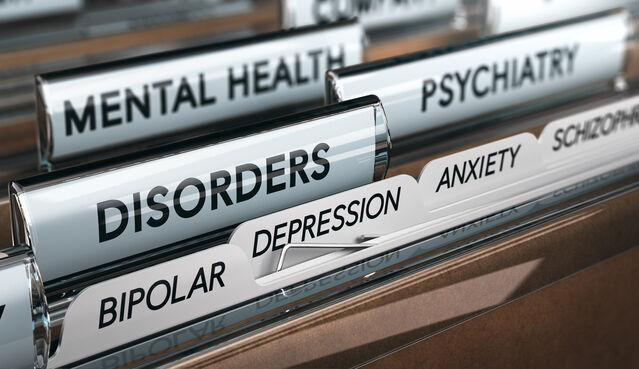Psychiatry
The Urgent Problem With Seeking Psychiatric Diagnoses for Every Problem
Psychiatrists can only help a few of the problems of the human condition.
Posted June 3, 2022 Reviewed by Tyler Woods
Key points
- There is a tendency to medicalize problems of the human condition, and a cultural expectation that all problems are fixable.
- There is confusion, even among psychiatrists, as to when to consider common human problems mental disorders.
- A small proportion of emotional, behavioral, motivational and self-regulation problems are amenable to psychiatric treatment or therapy.

"People really love to debate self-diagnosis and sort of criticize the trend of over-pathologization, and I think often that criticism is warranted. I personally believe that self-diagnosis and identity politics often tend to interact in a pretty dangerous way. But […] I think we can understand self-diagnosis and over-pathologization as a reasonable reaction to the fact that […] our society is not built to accommodate the wide spectrum of human need […] You have to say I have this need because I have this identity, I have this diagnosis."
TikTok video by @raynecorp1
Life can be extremely stressful and complicated. People often feel at a loss to know how to cope. Many assume that psychiatry has the answers to problems of coping with life and regulating one’s own emotions and behaviors. My profession is guilty of having oversold its role, and of having medicalized common human problems. But the problem is equally our society’s unrealistically high expectations of modern medicine and therapy. People turn not only to psychiatrists for solutions to their difficulties with coping and self-regulation but also to psychologists and other therapists. But the expectations and pressures on psychiatrists are particularly intense, as medical specialists who are designated as the ultimate gatekeepers for diagnoses of mental illnesses and, more broadly, mental disorders.2
“Having” anxiety or depression versus being an anxious or unhappy person3
Mental disorders are, by their very nature, difficult to define with specificity. Anxiety and depression are the most common reasons for seeking psychiatric help. There is much confusion among the general public, and even often uncertainty among psychiatrists, as to when to consider these experiences mental disorders: the diagnosis depends on severity, number of associated symptoms, degree of functional impairment, and persistence or recurrence. Unfortunately, psychiatric diagnostic classification systems and mental health awareness campaigns have overgeneralized the definition of mental illness.
The tendency now is to pathologize everyday problems, labeling them mental disorders.4 People have come to regard too much of the normal spectrum of anxiety and depression as illnesses—illnesses that somehow “happen” to people, categorically distinct from normal human experience. This is epitomized by the many patients who come to see me “to find out if I ‘have’ anxiety.”
While there is some validity to this illness model for the most severe forms, most anxiety and depression (and most other psychiatric problems) are more sensibly considered as simply representing one end of a spectrum (usually a bell curve) of normal human traits and tendencies. For many people, anxiety is simply part of their constitutional nature: their temperament, for better and for worse—it is who they are and how they are. (There are virtues that come with this temperament too—anxious people tend to be more sensitive, emotionally attuned, and cautious.)
Modest effects from treatment and or therapy
Unfortunately, even though our society has come to regard depression and anxiety as treatable disorders—and psychiatrists face a lot of pressure and expectations for successful treatment—the average success rate is modest. Some people do enjoy marvelous responses to treatment. Some are less lucky. Most obtain varying degrees of partial improvement.
I am talking here about data from well-designed medication and psychotherapy studies, controlling for nonspecific or random factors and placebo effects. Placebo effects augment responses and are highly dependent on expectations. While effective medications for depression and anxiety are definitely superior to placebo, the effects are far from dramatic when averaged across all patients. Nevertheless, fortunately people also frequently get better for reasons that have nothing to do with treatment and / or therapy.
The medicalization of motivational problems
Motivational problems are another frequent reason for people presenting to psychiatrists—or young people being brought by their parents to see a psychiatrist. People imagine or hope that there is a diagnosis and a treatment for all cases of low motivation, but the reality is that only a minority of cases meet the criteria for such.
I have written elsewhere about some of those cases, such as ADHD5—and to be sure, those cases are often missed and misattributed to attitude. It’s not so simple to identify the cases where medication or other therapeutic interventions can make a significant difference, particularly since ADHD characteristics are inseparable from the individual’s personality traits and habitual behaviors (ADHD is arguably best understood as one end of a normal continuum of neurodiversity, and its “treatments” can be better understood as performance enhancers). Meanwhile, awareness of diagnoses such as ADHD has become widespread, and people now commonly presume that motivational problems are treatable conditions. Alas, even when ADHD is a valid diagnosis, it often responds incompletely to treatments.
Possible reasons for increased seeking of diagnoses
Unsurprisingly, the COVID-19 pandemic drove up actual rates of anxiety, depression, and several other mental disorders. But the trend toward increased self-diagnoses of mental disorders, which has been a phenomenon particularly pronounced among young people, predated the pandemic by a number of years.
The data are complicated, but there does not appear to have been much rise in the actual rate of mental disorders pre-pandemic—particularly major mental illnesses.6 What appears to have increased is people’s perception that they need psychiatric treatment. The threshold for people seeking professional help, especially among young people, has lowered. Some of this represents people legitimately identifying and seeking help for significant problems, who, in the past, would have been inhibited by a lack of mental health literacy or stigma. But there is also a phenomenon of these diagnoses being sought after, having become curiously desirable.
A diagnosis offers a person an explanation for their difficulties. It lets a person feel understood. It simplifies complexity, helping make sense of things and bringing a bit of order to the inexplicable and chaotic. It provides validation and legitimacy to one’s struggles, as well as sympathy, and it might offer justification for one’s shortcomings or behavioral difficulties. It also confers a sense of identity and group-belonging (consider the above-quoted cautionary comment by the producer of the TikTok video, about self-diagnosis and identity politics).
Another factor may be the safetyism culture of our times.7 Young people’s anxiety is understandably heightened by their unprecedented awareness of physically and temporally distant societal threats.
A diagnosis may, of course, also deliver practical benefits: sick leave, disability benefits, academic accommodations, and insurance coverage for therapy.
Pharmaceutical marketing is obviously a big factor, too.
The other huge factors are, of course, the internet and social media, celebrity influence, peer influence, social contagion, and suggestibility. Notably, girls and young women tend to be more susceptible to many of these trends, perhaps, in part, because they are generally more socially connected than boys and young men.
In many ways, what we are witnessing is the success of, and unintended consequences of, years of mental health education and destigmatization campaigns.
Gen Z, social media, and mental health
Among large segments of today’s youth and young adults in Western societies, sharing experiences about one’s personal mental heath has become normalized as everyday conversation. Mental health is a frequent topic on social media, and perhaps especially on YouTube and TikTok, with influencers acquiring huge numbers of followers by talking freely about their own mental health problems and actual or self-diagnoses.
Some of this is very good, helping to reduce feelings of isolation or otherness in youth who are struggling with their own significant mental health problems. But there is also a risk that the powerfully seductive reinforcement of all those “likes” and “shares” may create an unhealthy incentive for people to embellish their problems for attention and sympathy (and, in some cases, for revenue).
Clinicians in a movement disorder clinic in London reporting on the phenomenon of an unusual spike in tic disorders among teenage girls noted the role of social media and websites such as TikTok that promote the sharing of videos by influencers with Tourette’s symptoms, which have exploded in popularity:
"Some teenage girls report increased consumption of such videos prior to symptom onset, while others have posted videos and information about their movements and sounds on social media sites. They report that they gain peer support, recognition and a sense of belonging from this exposure. This attention and support may be inadvertently reinforcing and maintaining symptoms. The role of social media needs further exploration, particularly the potential for ‘contagion’ and the maladaptive gains that might unintentionally arise from this peer identification."8
The consequences and risks of over-diagnosis
There are many potential risks and unintended consequences of over-diagnosis. For one, it leads to over-prescribing of medications.
Severe mental illness becomes trivialized. If everyone has a mental disorder, then no one does, and the concept of mental disorder becomes meaningless. It becomes harder for the people most in need of psychiatric services to access the already overloaded system.
Further, it may lead to an unrealistic loss of acceptance that stress and distress are inherent features of life, with unrealistic expectations that psychiatrists and psychologists possess solutions to life’s problems. This is a recipe for frustration and disappointment when the professional is simply unable to deliver on those solutions.
The pendulum has overshot
On the whole, the generational shift toward destigmatization and much greater openness of conversations about mental health is most certainly a positive development and is to be strongly welcomed and encouraged.
But moderating some aspects of the trend is urgently needed.
References
1. [@raynecorp]. (2021, September 21). #disability #ableism #nd [Video]. TikTok. https://www.tiktok.com/@raynecorp/video/7010522973819997445
2. These terms are not strictly defined, but the term mental illness can generally be understood to imply a more severe problem than the slightly broader term mental disorder.
3. Parts of this article are adapted from: Ralph Lewis, Finding Purpose in a Godless World: Why We Care Even If The Universe Doesn’t (Amherst, NY: Prometheus Books, 2018).
[Click 'More' to view footnotes 4-8].
4. A. Frances, Saving Normal: An Insider’s Revolt against Out-of-Control Psychiatric Diagnosis, DSM-5, Big Pharma, and the Medicalization of Ordinary Life (New York: William Morrow, 2013); Lawrie Reznek, Peddling Mental Disorder: The Crisis in Modern Psychiatry (Jefferson, NC: McFarland, 2015).
5. See When Your Unmotivated Teenager Fails to Find Purpose in Life, and Won’t or Can’t? Motivation and the Question of Free Will
6. Serious mental illness generally refers to illnesses such as schizophrenia and bipolar disorder. Even for anxiety disorders, the rates of strictly defined disorders do not seem to have changed much (at least pre-pandemic)—what has increased is symptoms rather than the full-blown disorder, e.g.
- Baxter, A. J., Scott, K. M., Ferrari, A. J., Norman, R. E., Vos, T., & Whiteford, H. A. (2014). Challenging the myth of an "epidemic" of common mental disorders: trends in the global prevalence of anxiety and depression between 1990 and 2010. Depression and anxiety, 31(6), 506–516. https://doi.org/10.1002/da.22230.
- John, A., Marchant, A. L., McGregor, J. I., Tan, J. O. A., Hutchings, H. A., Kovess, V., Choppin, S., Macleod, J., Dennis, M. S., & Lloyd, K. (2015). Recent trends in the incidence of anxiety and prescription of anxiolytics and hypnotics in children and young people: An e-cohort study. Journal of Affective Disorders, 183, 134-141. [7438]. https://doi.org/10.1016/j.jad.2015.05.002.
- Bandelow, B., & Michaelis, S. (2015). Epidemiology of anxiety disorders in the 21st century. Dialogues in clinical neuroscience, 17(3), 327–335. https://doi.org/10.31887/DCNS.2015.17.3/bbandelow
- Kosidou, K., Lundin, A., Lewis, G., Fredlund, P., Dal, H., & Dalman, C. (2017). Trends in levels of self-reported psychological distress among individuals who seek psychiatric services over eight years: a comparison between age groups in three population surveys in Stockholm County. BMC Psychiatry, 17(1), 345. doi:10.1186/s12888-017-1499-4.
- See also this infographic.
The prevalence data overall are mixed, complex and difficult to interpret, plagued by the question of whether increased rates represent a real increase or just an increase in diagnoses. Some studies have found an increase in the prevalence of psychiatric disorder diagnoses, e.g.
- Lipson, S. K., Lattie, E. G., & Eisenberg, D. (2019). Increased Rates of Mental Health Service Utilization by U.S. College Students: 10-Year Population-Level Trends (2007-2017). Psychiatric services (Washington, D.C.), 70(1), 60–63. https://doi.org/10.1176/appi.ps.201800332. The authors of that paper relate the increased service utilization and diagnoses in part to decreased stigma.
- Weinberger, A. H., Gbedemah, M., Martinez, A. M., Nash, D., Galea, S., & Goodwin, R. D. (2018). Trends in depression prevalence in the USA from 2005 to 2015: widening disparities in vulnerable groups. Psychological medicine, 48(8), 1308–1315. https://doi.org/10.1017/S0033291717002781.
- Twenge, J. M., Cooper, A. B., Joiner, T. E., Duffy, M. E., & Binau, S. G. (2019). Age, period, and cohort trends in mood disorder indicators and suicide-related outcomes in a nationally representative dataset, 2005-2017. Journal of abnormal psychology, 128(3), 185–199. https://doi.org/10.1037/abn0000410.
- Olfson, M., Blanco, C., Wang, S., Laje, G., & Correll, C. U. (2014). National trends in the mental health care of children, adolescents, and adults by office-based physicians. JAMA psychiatry, 71(1), 81–90. https://doi.org/10.1001/jamapsychiatry.2013.3074.
Girls show the most increases (suggesting social factors may be at play). Rates for boys seem to have been more stable over time.
See also:
- Is young people's mental health getting worse? (BBC)
- Mental illness: is there really a global epidemic? (The Guardian)
- The State Of Mental Health In America (MHA – Mental Health America)
- Most U.S. Teens See Anxiety and Depression as a Major Problem Among Their Peers (Pew Research Center)
- Data and Statistics on Children's Mental Health (CDC)
- Canadian Community Health Survey (Statistics Canada)
7. Greg Lukianoff and Jonathan Haidt, The Coddling of the American Mind: How Good Intentions and Bad Ideas Are Setting Up a Generation for Failure (New York: Penguin Books, 2019).
8. Heyman, I., Liang, H., & Hedderly, T. (2021). COVID-19 related increase in childhood tics and tic-like attacks. Archives of disease in childhood, archdischild-2021-321748. Advance online publication. https://doi.org/10.1136/archdischild-2021-321748.




